When we focus a report on a single origin, in this case El Salvador, we try to time the report so that we are testing mainly freshly arrived coffees, coffees that represent the best of the year’s new crop. This year, however, we were a bit too early with our report timing. Many of the coffees we cupped early in July lacked vivacity and aromatic range, suggesting perhaps that they were last year’s crop. So, we postponed our publication date by a couple of weeks, extended our deadline, and queried importers and roasters, trying to turn up fresh, new-crop El Salvadors as they landed.
To great degree, we succeeded. We managed to source recently arrived samples from many of El Salvador’s finest, most celebrated farms and suppliers. Not all of them, but a good cross-section. Nevertheless, we still were a bit disappointed, even by the new crop samples.
Still in Crisis
El Salvador suffered terribly from the devastating epidemic of coffee leaf rust disease that struck much of Latin America starting in 2012. Overall coffee production in El Salvador fell by an extraordinary 60 percent from 2012 to 2014. The destructive impact on coffee, and on the people who grow it, was incalculable. El Salvador especially suffered because it was, for many years, one of the darlings of high-end coffee, with large plantings of the distinctive varieties Bourbon and Pacamara, both celebrated for their exceptional cup profiles — but both, unfortunately, also susceptible to leaf rust disease and, consequently, very hard hit by the 2012 epidemic. By contrast, in neighboring Honduras, most fields had been planted with disease-resistant interspecific hybrids chosen more for their resistance to disease than for their distinctive cup character. During the two years that El Salvador’s vulnerable production plummeted, coffee production in Honduras increased (although that increase has recently leveled off).
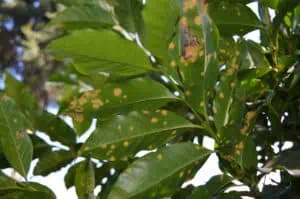
Coffee leaf rust in El Salvador. Courtesy of Jason Sarley.
But total production in El Salvador has been recovering, and we felt that 2019 would be a good year to check in again on El Salvador coffees and hopefully celebrate signs of recovery of this exceptional origin. But perhaps our timing was premature here, too. We did receive nearly 25 samples of the sweet-savory, big-beaned Pacamara variety, one of El Salvador’s coffee treasures, and nearly 10 samples from trees of the great heirloom Bourbon variety that once produced up to 80% of El Salvador’s coffee. But, in general, most of the samples even from these exceptional varieties rated in the 87 to 89 range: solid, pleasing coffees but either a bit short in energy and excitement on one hand, or persuasive balance and elegance on the other.
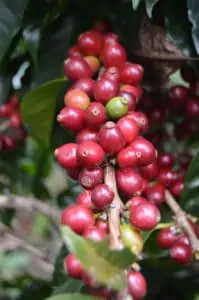
Fruit of the Pacamara variety of Arabica, Finca Las Mercedes, El Salvador. Courtesy of Jason Sarley.
We have only sketchy reports of bad weather disrupting the flowering and fruiting cycle this crop year. But the record is clear for previous years: first the rust epidemic, then erratic weather patterns almost certainly related to global warming. Rains sometimes come early, which makes the trees flower, but then the rains stop and things dry up. Between climate change and the ongoing threat of the rust disease, yields have plummeted even on the best-managed farms. The latest blow is all-time-low benchmark prices for standard-quality Arabica coffee. According to a 2018 USDA report on the El Salvador coffee sector, the country has lost an estimated 40,000 coffee jobs since the onset of the rust epidemic, contributing to crime, social unrest, and the wave of migration north. The Migration Policy Institute reports that nearly 20% of El Salvador’s population now lives in the United States.
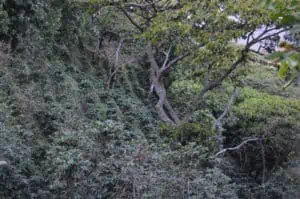
Coffee growing on the hillside at Finca Himalaya in El Salvador. Courtesy of Jason Sarley.
A friend of mine, who operates a small El Salvador farm, summarizes the situation: “The challenges that [El Salvador] growers face are related to change in climate and to drops in market prices that offer negative revenue stream to many growers. Climate change means that the level of quality once associated with a particular elevation may change. Hence more fertilizer and silicon needed to maintain quality. Climate change also means that fungus, plants, and animals malevolent to agricultural crops have increasingly better purchase at elevations once at least somewhat daunting to them. Negative revenue streams mean abandoned farms. Abandoned farms create unmitigated breeding grounds for these adversaries, often adjacent to or surrounding active cafetals. To make matters worse, as more and more agricultural workers are displaced, rural crime levels rise noticeably, in both frequency and in the level of violence.”
The Distinctive Exceptions
Despite all of these daunting challenges, some exceptional coffees came our way, distinguished both by their quality as well as their originality. Seven of those coffees, rated from 91 to 94, are reviewed here.
The Plat Coffee El Salvador, top-rated at 94, is a poised and complete example of wet-processed Bourbon character, sweetly lavish in fruit and floral aromatics, yet crisp with nut and dry chocolate — a throwback, perhaps, to great wet-processed El Salvador Bourbons of years past. The 93-rated PT’s Coffee La Avila SL28 El Salvador is also a wet-processed coffee, but from trees of the Bourbon-related SL28 variety famous for its contribution to the great coffee tradition of Kenya. Here the nut-toned, sweet-savory character leads into the cup, but just behind and around it a deep, layered complexity emerges, gently zesty and vivid.
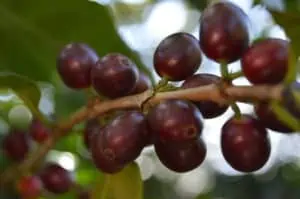
The Bourbon variety of Arabica. Courtesy of Jason Sarley.
The pattern of a savory-leaning, nut-toned character balanced and lifted by fruit or floral sweetness was characteristic also of the remaining five coffees reviewed here. In the case of the wet-processed JBC Talquezar El Salvador (92), the contrast was both deeply resonant and delicate. With the natural- or dry-processed samples like the Willoughby’s Finca Kilimanjaro (92) and the Duluth José Flores Pacamara Natural (91), the nut-toned tendency was a bit more bitter than in the wet-processed samples, but the balancing fruit was also sweeter and more explicit. The Deeper Roots Mario Aguilar El Salvador (a wet-processed Pacamara, 91) displayed a nicely balanced bittersweet nut (we called it candied walnut) with a pronounced dark chocolate helped along by a slight touch of roast influence. Finally, the Dinwei Café Finca San Antonio El Salvador (92) is a honey-processed coffee produced from trees of the celebrated Geisha variety, newly introduced to El Salvador. It displayed a mild but gently original version of the cocoa-and-flowers Geisha genius.
The Uncertain March of the Naturals
Of the 54 coffees we tested, almost half were natural-processed (dried in the whole fruit), and another 25% were honey-processed (skin removed, but dried in all or part of the fruit flesh or pulp). This is a complete turnaround in processing method for El Salvador. Until just a few years ago, the standard processing method for fine coffee in El Salvador, as well as in most parts of the world, was the washed or wet method, in which the skin and sweet fruit pulp is immediately stripped from the seeds or beans before they are dried, preventing the fruit pulp from fermenting or going musty during drying, potentially tainting the cup. If everything is done right during wet processing, the result is usually a relatively bright, vivacious cup, with clean fruit notes and distinct florals.
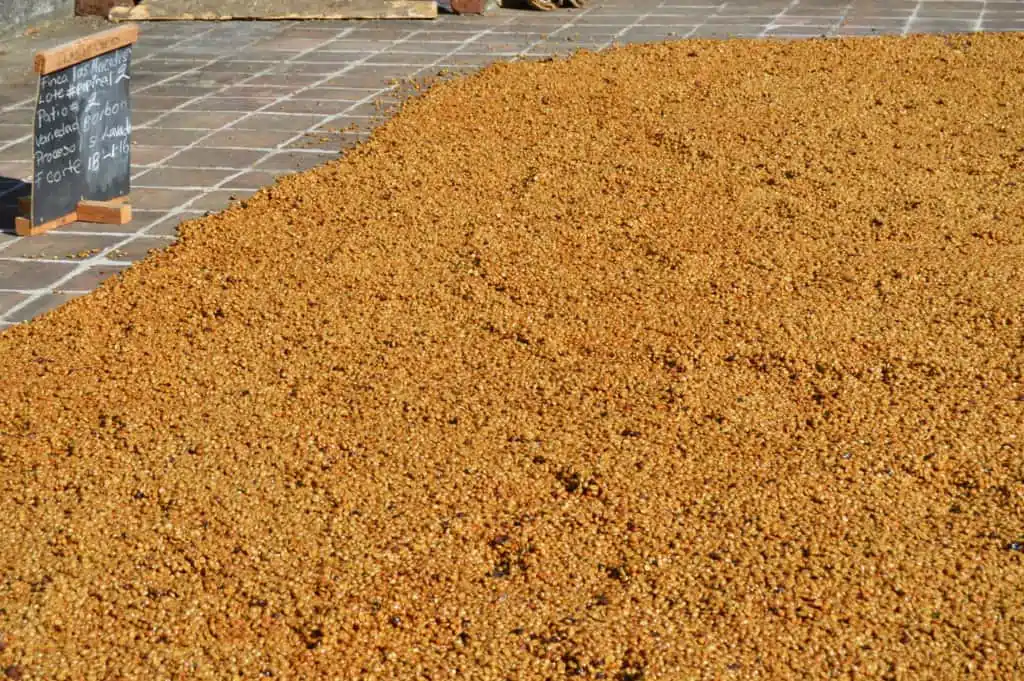
Honey-processed drying at Finca Las Mercedes, El Salvador. Courtesy of Jason Sarley.
Starting with the success of Starbucks’ Sherkina Sundried Sidamo in 2005, the specialty community began to discover the possibilities and pleasures offered by drying the coffee in the entire fruit: the natural or dry method. When it works, the natural process adds a fruity, juicy, often alcohol-tinged sweetness to the cup that has seduced a generation of roasters and coffee drinkers, including me. When it doesn’t work, however, which can happen because of the long period of drying inside the fruit in often less than ideal conditions, the fruit either over-ferments, producing a range of notes from vaguely rotten to mulchy, or stays relatively clean-tasting but dries out and encourages a nut- or wood-dominated cup.
A Lot of Naturals, Not a Whole Lot of Fruit
Twenty-four of the fifty-four coffees we tested for this report were natural-processed, and of those 24, none quite fit the cleanly lush yet balanced, opulently fruit-forward style of natural many consumers look for, and that we tend to give high ratings to on Coffee Review. True, two naturals we review here, the Willoughby’s Finca Kilimanjaro and the Duluth José Flores Natural, did show some quietly vibrant natural fruit. Some of the other naturals we tested were fruit-forward yet disturbingly uneven. But the main issue with most of the naturals we tested was a nut-toned, woody simplicity.

Aida Battle and Gabriela Flores of Finca Kilimanjaro. Courtesy of Jason Sarley.
Perhaps the weather did not cooperate during drying, or the best naturals didn’t make it to roasters in time for our report. Some of the better-known El Salvador farms are established masters of the natural method, but possibly the great majority of El Salvador producers are just learning about the challenges of the newly fashionable natural method. Certainly there are profound advantages to the producer with the natural method: no need to clean fermentation and wash water fouled during processing, less fussy equipment to maintain, and the implicit promise to the buyer that the coffee is different or exciting — not the same-old Central America washed cup. If producers find that they are not getting enough money to cover cost of production for standard wet-processed coffees, why not roll the dice and go for specialty prices by offering something different?
Washed Coffees Dominate at the Top
Nevertheless, the traditional washed samples we tested impressed us more overall than the natural or honey samples. Of the samples we rated 90 or higher, 60% were wet-processed, 30% were natural-processed and 10% were honey-processed. Whereas for the cupping as a whole, 35% of the tested samples were wet-processed, 44% were natural and 26% honey.
Refining Naturals
What has to happen now, it seems to me, is that industry professionals need to begin to more mindfully distinguish between successful naturals and less successful naturals, more successful experiments and less successful experiments, and develop criteria that can be translated into practical protocols for achieving sensory success when preparing such alternative-method coffees at the farm or mill. These protocols appear to exist already at the individual farm level in Central America, but perhaps the word needs to be gotten out more widely. Certainly, coffees like many of the naturals we tested these past few weeks, dominated by bittersweetness with minimal compensating fruit or chocolate, will not charm consumers for very long.
But the best of this year’s El Salvadors were quite good, and much of the 2019 crop is just arriving at roasters. Most likely, more soaring wet-processed Bourbons and rich, resonant, fruit-nuanced natural Pacamaras will surface at specialty roasters this summer and fall. Look for them.
And stick with El Salvador generally, just as U.S. coffee roasters appear to be doing. Support those legislators who want us to deal forcefully with global warming, and who might be willing to back efforts to invest more in agriculture and development in Central America to keep people at home rather than to spend enormous sums to build a wall at the border to keep them out once they are displaced and suffering.










